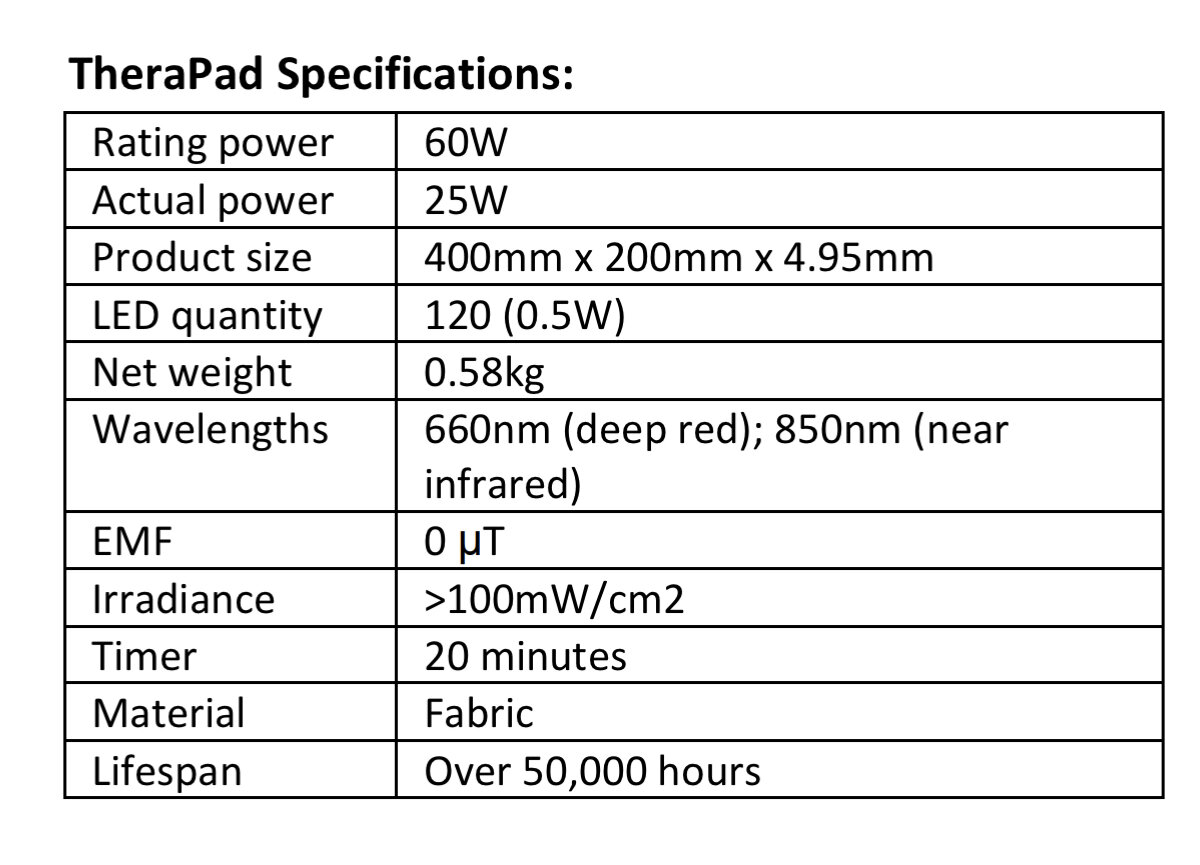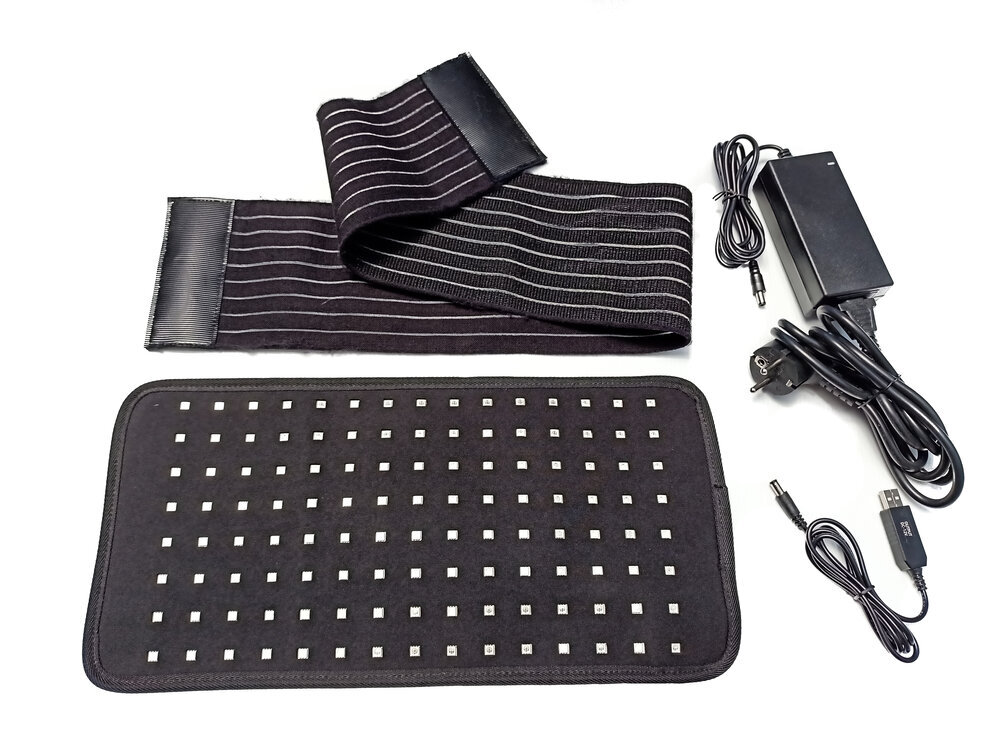TheraPad
Your first Therapad session
1. Connect the plug to your TheraPad and turn it on at the power point
2. Place the TheraPad over the painful area. Make sure that you can easily reach the button next to the plug insertion.
3. Select your preferred option:
Continuous light – quick press and you’ll see the button light up green
● Press the button once and all LEDs will come on, both 660nm and 850nm
● Press again, and only the red 660nm LEDS will be on
● Press again, and only the near infrared 850nm LEDs will be on (you can’t see them, but you can feel the warmth)
● The fourth press turns off all the LEDs and the button’s green light.
Pulsed light –press for more than three (3) seconds and you’ll see the button light up blue
● Press the button once and all LEDs will come on, both 660nm and 850nm, pulsing
● Press again, and only the red 660nm LEDS will be on, pulsing
● Press again, and only the near infrared 850nm LEDs will be on, pulsing, but very hard to see.
● The fourth press turns off all the LEDs and the button’s blue light.
Your TheraPad will turn itself off after twenty (20) minutes
What is the TheraPad?
The Therapad is a flexible light device designed to shine red and/or near infrared LED lights directly onto the body.
What is the TheraPad used for?
To reduce pain and inflammation from:
sore muscles
pulled tendons
joint pain
inflammatory pain
skin wounds
How often should the TheraPad be used?
At least once daily, preferably twice daily on each painful part.
What LED lights are used?
The TheraPad uses inbuilt LED lights in two wavelengths:
660nm – a deep red colour which is very easy to see
850nm – near infrared and just at the edge of our visibility. You can’t easily see the 850nm LEDs when they are on, but you will feel their warmth.
How do the TheraPad’s red and near-infrared lights work?
The TheraPad’s red and near infrared LED lights are able to:
penetrate through skin and bone and into underlying tissues, extending to a depth of 50mm (just over 2 inches), and
activate the cell by creating a small chemical change in the wall of the cell battery (mitochondrion)
This chemical change results in:
increase in the cell’s activity levels – whatever that cell is supposed to do, the cell will now do it better.
activation of the cell nucleus, starting the process of making completely new cells.
change in the fluid chemistry around the cell, leading to the creation of new branches in the surrounding blood vessels. This ultimately brings more oxygen to the area in pain.
How soon before I can feel a change?
It depends on the kind of problem you have, but most people find that the pain and discomfort reduce within a few days. Some notice improvements very quickly.
Do I have to use the TheraPad every day?
Once you have the pain, inflammation and/or discomfort under control, you will find that you will need to use it less often.
There is value in using it once daily, as there is good evidence that these wavelengths pre-condition and protect muscles.
What options does the TheraPad offer?
You can choose one of six settings:
Continuous Red and Near-infrared shining together
Continuous Red only
Continuous Near infrared only
Pulsed Red and Near-infrared shining together
Pulsed Red only
Pulsed Near infrared only
How long is a TheraPad session?
The TheraPad automatically turns itself off after twenty (20) minutes.
References:
Hamblin MR. Mechanisms and applications of the anti-inflammatory effects of photobiomodulation. AIMS Biophys. 2017;4(3):337-361. doi:10.3934/biophy.2017.3.337
Rodrigues M, Cardoso RB, Kuriki HU, Marcolino AM, de Oliveira Guirro EC, Barbosa RI. Photobiomodulation Decreases Hyperalgesia in Complex Regional Pain Syndrome: An Experimental Mouse Model Subjected to Nicotine. Lasers in Surgery and Medicine. Published online 2020. doi:10.1002/lsm.23240
Hu D, van Zeyl M, Valter K, Potas JR. Sex, but not skin tone affects penetration of red‐light (660 nm) through sites susceptible to sports injury in lean live and cadaveric tissues. J Biophotonics. 2019;12(7). doi:10.1002/jbio.201900010
Yue L, Humayun MS. Monte Carlo analysis of the enhanced transcranial penetration using distributed near-infrared emitter array. J Biomed Opt. 2015;20(8):088001-088001. doi:10.1117/1.JBO.20.8.088001
Mitrofanis J, Run in the Light, Morgan & Claypool, 2019.
Hamblin MR. Mechanisms and Mitochondrial Redox Signalling in Photobiomodulation. Photochemistry and Photobiology. 2018;94(2):199-212. doi:10.1111/php.12864
Lang-Illievich K, Winter R, Rumpold-Seitlinger G, et al. The Effect of Low-Level Light Therapy on Capsaicin-Induced Peripheral and Central Sensitization in Healthy Volunteers: A Double-Blinded, Randomized, Sham-Controlled Trial. Pain and Therapy. Published online 2020. doi:10.1007/s40122-020-00205-0
Andrade ALM, Brassolatti P, Luna GF, et al. EFFECT OF PHOTOBIOMODULATION ASSOCIATED WITH CELL THERAPY IN THE PROCESS OF CUTANEOUS REGENERATION IN THIRD DEGREE BURNS IN RATS. Journal of Tissue Engineering and Regenerative Medicine. Published online 2020. doi:10.1002/term.3028References



